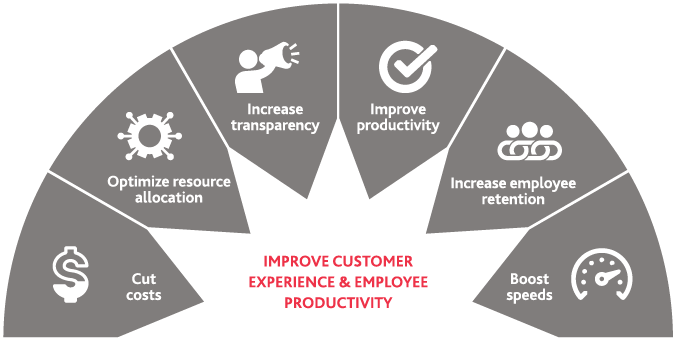Section 2: Digital Transformation Drivers
1. INCREASING REVENUE & PROFITABILITY
Nearly every business initiative shares a similar goal: to boost company growth and revenue. Digital transformation is no different. Luckily, survey findings indicate that digital transformation efforts, when done well, do lead to better business outcomes—both in the short-term and in the future. By streamlining wieldy business operations and enhancing customer experience, digital transformation can help companies open up new revenue streams, bolster current ones, and outpace competitors in innovation.
Revenue Growth from Digital Initiatives
LAST 12 MONTHS:
-
71% of businesses experienced a revenue increase from digital initiatives.
NEXT 3 YEARS:
-
81% anticipate a revenue increase from digital initiatives.
*Excluding businesses that had/have no planned digital initiatives
Profitability Growth from Digital Initiatives
LAST 12 MONTHS:
-
74% of businesses saw an increase in profitability from digital initiatives: 18% by 10% or more.
NEXT 3 YEARS:
-
79% anticipate an increase in profitability from digital initiatives: 40% by 10% or more.
*Excluding businesses that had/have no planned digital initiatives
THE BOTTOM LINE:
While digital transformation can be an incredibly time-consuming and resource-intensive process, it’s necessary for business leaders looking to boost long-term revenue growth and profitability.
2. IMPROVING CUSTOMER EXPERIENCE
Sixty-nine percent of businesses cite improving customer experience as one of their top three long-term business goals—and it’s no wonder. Customer experience is now more important than ever, as today’s consumers expect faster response times, more personalized offerings, and greater accessibility to products and services.
THE BOTTOM LINE:
Producing high-quality products and services is no longer enough—organizations must also deliver a seamless experience that will delight users, or they risk losing customer loyalty. Digital transformation is the cornerstone to making this happen—offering opportunities to automate and enhance customer service interactions, increase accessibility to key products and services via a diversity of platforms, and cater personalized experiences through predictive analytics. Technology has already radically transformed consumer behavior, and companies must be prepared to change with it—including introducing new business models.
3. BOOSTING OPERATIONAL EFFICIENCY
From robotic process automation to cloud computing, new technologies have already radically transformed and improved the way companies operate—internally and with their customers. It’s little wonder that survey participants cite reducing operational inefficiency as one of their top three short- and long-term business goals. These percentages are even higher among organizations that are already implementing, or looking to implement, a digital transformation strategy—a testament to their belief that strengthening their digital capabilities will boost long-term productivity and customer experience.
Reducing Operational Inefficiency is one of Companies' Top 3 Short-and Long-Term Business Goals

Benefits of Streamlining Operations

THE BOTTOM LINE:
Digital transformation can not only elevate a company’s brand to the next level, but provide it with the tools, processes, and resources needed to streamline critical operations, cut costs, and boost profitability. Organizations must constantly push themselves to become faster and stronger—or their competitors will.
SHARE